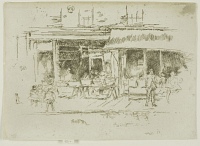Etchings Institutions search term: grolier club
Nut Shop, St James's Place, Houndsditch | ||
| Number: | 356 | |
| Date: | 1887 | |
| Medium: | etching and drypoint | |
| Size: | 128 x 178 mm | |
| Signed: | butterfly at left and (faint) at lower right | |
| Inscribed: | no | |
| Set/Publication: | no | |
| No. of States: | 2 | |
| Known impressions: | 5 | |
| Catalogues: | K.291; M.285 | |
| Impressions taken from this plate (5) | ||
KEYWORD
TITLE
'Hounsditch Series' (1887/1888, Whistler). 2
'St James Place. [crossed out] Nut Shop' (1887/1888, Whistler). 3
'Nut Shop (Houndsditch)' (1888, Whistler) 4
'Nut Shop' (1889, Whistler). 5
'Nut Shop, St. James’s Place, Houndsditch' (1898, Wunderlich's). 6
'Nut Shop, Houndsditch' (1900, Caxton Club). 7
'Nut-Shop, St. James's Place' (1902, Edward Guthrie Kennedy (1849-1932)). 8
The Nut Shop. St. James's Place' (1903/1935, possibly Rosalind Birnie Philip (1873-1958)). 9
'Nut Shop, St James’s Place, Houndsditch' combines elements of Whistler's and later titles, and is the correct spelling. The alternative spelling, 'Hounsditch', is acceptable but less common.
3: List, [1887/1888], GUW #13233.
4: Whistler to Wunderlich's, 29 June 1888, GUW #13052.
5: List, 18 July 1889, GUW #13235.
6: New York 1898 (cat. no. 191).
7: Chicago 1900 (cat. no. E307).
8: Kennedy 1902 (cat. no. 301).
9: Envelope containing copper plate, Hunterian Art Gallery.
DESCRIPTION
SITE
10: Henry Mayhew, London labour and the London poor, London, 1851, at http://archive.org (accessed 2012).

